
VOL. II NO. 5 REG NO. L5015 DELHI, FRIDAY OCTOBER 15, 1943
14TH AIR FORCE HAMMERS JAPANESE
ENEMY OPPOSITION WEAKENING
THREE VISITS MADE TO HAIPHONG BASE
CHUNGKING - Bombers and fighter-bombers of the 14th Air Force are continuing to hammer widespread objectives in Jap-occupied China, French Indo-China and northern Burma in the face of Japanese opposition so weak as to indicate that both Japanese aerial strength and pilot morale have taken a terrific beating in this area in recent weeks.
During the Oct. 4-19 period, covered in the most recent communiques from the 14th Air Force Headquarters, very few attempts at interception were made by the Japs to protect vital areas from heavy bombing. Even when interceptions were made, they were half-hearted affairs in small force, with the Japanese pilots showing a decided disinclination to press home attacks at close quarters.
In the early part of the period covered by the comminuques, the Japs made two light raids on advanced U.S. bases. On Oct 4, a formation of enemy bombers attempted a raid but, though only partially intercepted, jettisoned their bombs and turned tail for home when P-40's went up to meet them. The next day it was the same story, with three waves of enemy fighters being turned back before even coming close to their objectives.
HAIPHONG RAIDED SECOND TIME
In the meantime, U.S. bombers and fighters struck back Oct. 5 and 6, scoring several near misses on two 250 to 300-foot Japanese freighters near Kiukiang on the 5th and raiding Shihhweiyao on the 6th, where hits were made on storage buildings and iron foundry installations.
On Oct. 7, the 14th was out again, raiding Haiphong in French Indo-China for the second time in a week to hit the cement plant there with excellent results. On this occasion the Japs made one of their interception attempts, at a cost to them of four planes confirmed and one probable. One the same day, medium bombers hit a 200-foot Jap freighter off the coast of China and left it burning and listing severely.
No interception was encountered when Gialam airdrome, near Hanoi, was raided on the 8th and several enemy bombers are believed to have been destroyed on the ground when hangars were hit. China shipping was a major objective the next day, when Mitchell bombers scored two direct hits on a 150-foot tanker, which was seen to sink in two minutes, and a patrol ship was bracketed with near misses. The same day, fighter-bombers hit Tinga, near Mangshih airdrome in north Burma, hitting oil and gas storage dumps.
SEVEN MORE ENEMY PLANES BAGGED
On the 10th, B-24's raided the docks at Haiphong for the third time in 10 days. More than 45 tons of bombs were strung along the docks and direct hits were seen on barracks and large warehouses. Also on the 10th, fighter-bombers raided the jap-occupied towns of Tengchung and Lengling in northern Burma, causing fires and explosions.
The score for the period in enemy planes shot down was seven confirmed and two probable. Two of our planes failed to return from missions.
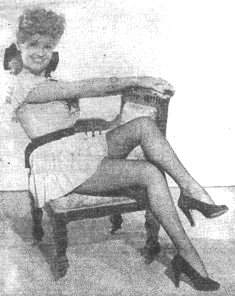 Guess who? And if you don't answer Betty Grable right off the bat you must have been shipped to the CBI Theater
straight from a hermit's cave in the wilds of the Rocky Mountains. This picture fulfills requests from G.I. students of anatomy who have been complaining the Roundup hasn't been stressing enough shapely feminine fibulas, tibias, and femurs.
Guess who? And if you don't answer Betty Grable right off the bat you must have been shipped to the CBI Theater
straight from a hermit's cave in the wilds of the Rocky Mountains. This picture fulfills requests from G.I. students of anatomy who have been complaining the Roundup hasn't been stressing enough shapely feminine fibulas, tibias, and femurs.
|
JAP EXCHANGE SHIP CLEARS BOMBAY
BOMBAY - About 1,200 Americans passed through here en route home from Japanese-occupied territory on the enemy exchange ship, Teia-Maru, which is also carrying 300 neutral nationals. The ship will meet the Allied exchange vessel, Gripsholm, at a Pacific port shortly.
'Carry On' HE SAYS GOODBYE
Editor, CBI Roundup: Please convey these lines by me to my friends of the CBI Theater:
Seventeen months ago, we came to these shores sharing our good times and hardships. It has been my misfortune to have an illness and soon I will be sent home. I deeply regret that I am unable to stay and help finish the job and want to wish you the best of luck until we meet again.
Yours Sincerely, Sgt. M. J. ROSADO
NEW DELHI AGLITTER
WITH GOLD BRAID, STARS
New Delhi, traditional habitat of the red tab and the brasshat, last week glittered with gold braid and additional stars.
The gold braid was furnished by Lord Louis Mountbatten & Co., while Lt. Gen. Joseph W. Stilwell added three stars to what was probably the most imposing display of military and diplomatic factotems in the history of this town. T. V. Soong, Chinese Foreign Minister, was in and out en route from Washington to Chungking, where Mountbatten is expected to confer with the Generalissimo.
What went on is not known even to the Roundup which is noted for exclusive pipelines into the inner sanctorums of the mighty.
Uncle Joe just tilted his old campaign hat on the back of his head and leered over his cigarette holder. Mountbatten was handsome, dashing, definitely charming, but looked, nevertheless, like a guy who would be tough to handle in a brawl. Soong was inscrutably and courteously Chinese.
We'd like to make some predictions but we picked the St, Louis Cards to beat the Yankees, so to Hell with us.
A Rat
WHICH MAKES 17 FOR MR. BENKO
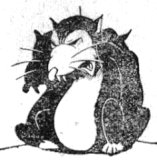
CHINA - After T/Sgt. Arthur J. Benko alighted from the B-24 Liberator from which he had just finished knocking down seven Jap Zero planes to boost his score to 16, a sharp-eyed observer noticed what he thought were two shrapnel tears in the gunner's flying jacket.
"No, they were knawed by rats," he answered, allaying fears. (Although he was nicked slightly on the left wrist and neck during the aerial scrap by a slug which tore through the glass turret.)
Benko revealed he had ambushed the rat a few nights previously with his pistol. He thus has 17 rats confirmed... 16 of them Japs.
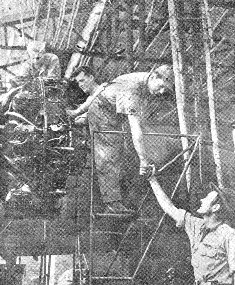 "Fine work," says one Alabaman to another. Maj. Robert Puckett, of Birmingham, "Bombing Eagle Squadron" commander,
congratulates T/Sgt. H. L. Campbell of Montgomery, for outstanding maintenance work. Campbell's plane, No.13,
assigned to Capt. Wilmer E. McDowell, of Salem, Ore., flew 26 days in one month in over 117 hours of operational
flight. During this time, it was out of service only one half a day and participated in 15 straight missions without
a turnback in monsoon weather. Other members of the efficient crew are S/Sgt. K. H. Knueven, above engine, and Cpl.
G. Fisher, behind Campbell.
"Fine work," says one Alabaman to another. Maj. Robert Puckett, of Birmingham, "Bombing Eagle Squadron" commander,
congratulates T/Sgt. H. L. Campbell of Montgomery, for outstanding maintenance work. Campbell's plane, No.13,
assigned to Capt. Wilmer E. McDowell, of Salem, Ore., flew 26 days in one month in over 117 hours of operational
flight. During this time, it was out of service only one half a day and participated in 15 straight missions without
a turnback in monsoon weather. Other members of the efficient crew are S/Sgt. K. H. Knueven, above engine, and Cpl.
G. Fisher, behind Campbell.
|
MONSOON SEASON ENDS -
10TH A.F. CELEBRATES
With the monsoon season "officially" at an end, the 10th Air Force this week celebrated by stepping up its tempo of attacks on rail centers, warehouses, barracks and bridges all ove the map of Burma. Heavies, mediums and bombers all did their part in making a shambles of enemy installations and facilities.
Outstanding events of the week were the pasting of the Meza River bridge, near Naba Junction, and a 2,000-mile round-trip by the B-24's to the Kanbauk tin mines. One central span of the Meza bridge now lies at the bottom of the river, and three approach spans were demolished, as well as two smaller bridges near Kiaukse. Direct hits were scored on the main buildings of the Kanbauk mines and a water pipeline was broken at several points.
The week began auspiciously with a successful raid on Meiktila, 80 miles south of Mandalay, on Oct. 5. Mediums wrought heavy destruction on workshops and offices close to rail sidings. At nearby Thedaw, a large building adjacent to the landing field was demolished and, on the same day, heavy damage was done to trackage at the Chauk railroad yards.
The next two days also were red-letter days for the mediums, with Ye-U, Monywa, Kalewa and Singaingmyo furnishing targets. Widespread damage was done to tracks and rolling stock and storage buildings and barracks were left burning.
Oct. 8 was marked by a three-cornered attack on Lashio, Hsipaw and Maymyo. The heavies ruined Jap barracks at Lashio, while the mediums gave a good shellacking to buildings and tracks at Hsipaw and Maymyo. Kawlin, in central Burma, also was attacked, but clouds prevented observation of results.
The 9th was the day of the long-distance attack on the Kanbauk tin mines and the 19th found the heavies hammering the Meza bridge. In addition, B-25's hit tracks and yards at Sagaing and Mandalay, destroyed a large number of cars at Kiaukse, bombed and strafed a Jap camp at Kaimaing and smashed more than 200 "goods wagons" at Naba Junction. The mediums also caused large explosions and fires at Pintha and left more fires burning at Natchaung. The peashooters bombed buildings at Taro and Lakchang Ga, including what is believed to be Jap headquarters at Taro.
No interception was encountered in the course of the week's operations and all U.S. planes returned to their bases.
RELIGIOUS CHIEFS TOUR CBI THEATER
BOMBAY - Two important members of America's "Spiritual High Command" are now touring the C.B.I. Theater. They are Deputy Chief of Chaplains George F. Rixey and Dr. William Barrow Pough, Chairman of the General Commission on Army and Navy Chaplains of the Federal Council of Churches of Christ in America. Rixey and Pough are making a tour of all war theaters, at the direction of President Roosevelt.
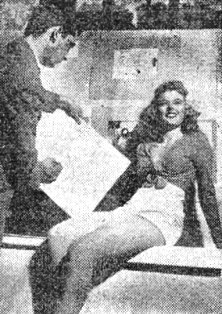 It's nice work if you can get it. Taking a cue from the G.I. custom of tacking pictures of pin-up girls on locker
walls, the American Society of Magazine Cartoonists has chosen one of its own. She is Jane Kean, here being sketched
by Ponce de Leon, who appears to have found something better than the Fountain of Youth.
It's nice work if you can get it. Taking a cue from the G.I. custom of tacking pictures of pin-up girls on locker
walls, the American Society of Magazine Cartoonists has chosen one of its own. She is Jane Kean, here being sketched
by Ponce de Leon, who appears to have found something better than the Fountain of Youth.
|
Unit in China 'Sweating Out' An Ace Fighter
CHINA - The "Flying Wall of China" Squadron, which used to sport more aces than a double pinochle deck, now finds itself "sweating out" Lt. Roderick P. MacKinnon.
This carrot-haired pilot of the Forward Echelon of the 14th U.S. Air Force started to weave his laurel wreath over one of our advanced airdromes in China when, accompanied by seven other Eager Beavers, he attacked 24 bombers and their escort of 30 Zero-type fighters. After the battle, MacKinnon claimed one probable which was later confirmed.
Following this, he knocked down one Zero confirmed and a probable over Canton while on a bomber-escort mission. Another bomber-escort, a few days later, brought him still another confirmed Zero. Total score at press time: Three confirmed and one probable. It raises our hopes to the point where we believe we'll soon regain our place in the sun. That's the Chinese sun, of course. - T/Sgt. JOSEPH D. TAYLOR
ANYTHING CAN HAPPEN
CHINA G.I.'S PASS UP GALS FOR OFFICERS
CHINA - Proving that anything can happen in China (and usually does) and also proving the crying need for a Section Eight Board for the men here in the Rice Bowl, the following tale is vouched for by Lt. Edwin James, Special Services Officer.
A dance was a-brewin' for the enlisted men of one of the 14th Air Force's ripsnorting fighter squadrons, so James hustled into the village and rounded up 30-odd of China's fairest maidens. But the G.I.'s held a meeting and decided NOT to have the girls, but, rather, to invite the OFFICERS of their organization and make it strictly a stag affair.
This action has had a marked effect on James. He is still muttering and marvelling over it.
|
Famous Artist Draws 'Jiggs' Insignia
During World War I, George M. McManus, creator of the famous American comic strip character, "Jiggs," served in France as a member of the original squadron from which the "Sky Dragons," pioneer medium bombardment squadron of the 14th Air Force, traces its history.
It was in the course of this overseas service that McManus designed the well-known insignia - a plump, jovial "Jiggs" stepping out in a high, wide and handsome style, with a bomb tucked under his left arm and the inevitable cane in his right hand.
This January, Capt. Paul E. Housel, executive officer, wrote to McManus, asking him if he would draw the "Jiggs" that appeared on the bombers of the 1917-18 squadron. In the intervening years, the original design had suffered changes during the process of recopying hundreds of times.
It's a long way between the C.B.I. and home. So it wasn't for six months that the autographed pen and ink drawing of the first insignia finally arrived. Mcmanus inscribed a personal touch of his by adding: "Good luck, Boys, and God Bless Every One of You."
Bulldog Snyder Sets The Pace
PILOTS LEAD BULLDOZER ON ROAD THROUGH JUNGLE
WITH THE U.S. ARMY ENGINEERS IN BURMA - A hardbitten, little 24-year-old U.S. Army sergeant sets the pace that's pushing the Ledo Road through the Burma jungles.
For 10 hours daily, seven days a week, rain or shine - and monsoons mean a lot of the former - Sgt. Clarence (Bulldog) Snyder, of York, Pa., mans the controls of the lead bulldozer that is spearheading the mass of manpower and machinery toward an undisclosed destination.
Officers and men who have worked around Snyder and his "cat" say that about the only time he is not cussing is when he is biting into Indian-made cigars, which Bulldog uses to offset the shortage of American chewing tobacco.
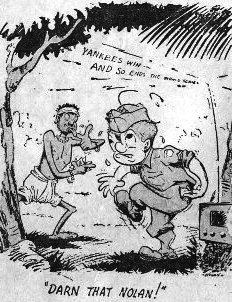
|
Snyder, who carries 135 pounds on a frame just under 5 feet 9 inches tall, admits that he does some cussing "when those big rocks and trees get in the way of my 'cat'," and you can watch all day without finding scarcely a full minute when the tight jungle hasn't conjured some sort of an obstacle. Each of these barriers represents a personal challenge to Bulldog, and he's highly pleased when demolition men fail to blast away boulders the size of the front hallway at home or trees so large they would keep your fireplace burning all winter.
Bulldog's battle is not only against boulders and trees, but also against landslides and the conspiring monsoons. Snyder has been landslided three times already - on one occasion his bulldozer was smashed so that it had to be towed for repairs, but he was back on the job as soon as another 'cat' arrived on the scene. It's a rare day when the forward bulldozer doesn't get stuck once or twice and a tractor doesn't have to come to the rescue. Bulldog is his own mechanic and takes care of everything in this department except major repairs.
Prior to joining the Army in April of last year, Snyder had three years of civilian experience operating a similar machine for construction firms around York, Pa. Bulldog reflected on his civilian experience, saying: "We used to think we had hard jobs back there, but this country is about as tough as God could make it."
Snyder has spent nearly all of his time in the Army outside the United States. Before coming to this theater, his regiment built an airport in Canada - a job that private construction firms turned down because it was "impossible." In Canada, the men wore long G.I. woolen underwear and parkas and worked in temperatures that dipped as low as 40 to 50 degrees below zero in direct constrast to the steaming heat of the Burma jungle that strips men to their waists.
In the meantime, Bulldog is looking forward to two things - getting the road finished and the arrival of some "honest to God American chewing tobacco."
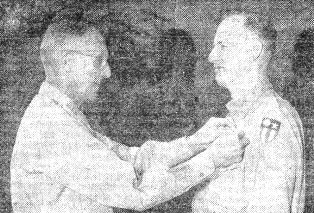 During his recent visit to New Delhi, Lt. Gen. Joseph W. Stilwell took time out to confer the Legion of Merit upon
his Deputy Chief of Staff, Brig. Gen. B. G. Ferris. The War Department thus honored Ferris for his exceptional handling
of supply problems, as former G-4 of the First Army.
During his recent visit to New Delhi, Lt. Gen. Joseph W. Stilwell took time out to confer the Legion of Merit upon
his Deputy Chief of Staff, Brig. Gen. B. G. Ferris. The War Department thus honored Ferris for his exceptional handling
of supply problems, as former G-4 of the First Army.
|
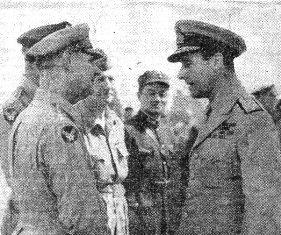 It was a significant occasion when Lord Louis Mountbatten, right, stepped out of a plane at New Delhi. With him,
the recently-appointed East Asia Commander brought the timetable by which the Jap will be brought to his knees. At the
airport to greet Mountbatten were, left to right, Maj. Gen. George E. Stratemeyer, Brig. Gens. Howard C. Davidson
and B.G. Ferris, of the U.S. Army, and Col. Irving Dooh Wu, resident Chinese military observer.
It was a significant occasion when Lord Louis Mountbatten, right, stepped out of a plane at New Delhi. With him,
the recently-appointed East Asia Commander brought the timetable by which the Jap will be brought to his knees. At the
airport to greet Mountbatten were, left to right, Maj. Gen. George E. Stratemeyer, Brig. Gens. Howard C. Davidson
and B.G. Ferris, of the U.S. Army, and Col. Irving Dooh Wu, resident Chinese military observer.
|
Bike Race
FIRST EVENT HELD BY INDIA G.I.'S
EAST INDIA AIR BASE - India's first bike race by United States troops was staged here on a recent Sunday over a five-mile course with S/Sgt. Speedy Rightbower as the peddle-pumpingest man in the field of 12 entrants.
With a movie truck out in front grinding away at the dust covered G.I. cyclists and an ambulance carrying Capt. W.A.R. Boben, of the Medics, and Harriet Gleason, of the Red Cross, trainling the field to pick up any "casualties," the caravan disappeared over a distant hill in a cloud of dust, looming back into view 21 minutes later with Rightbower followed by Sgt. Caldwell, Cpl. Gross, Sgt. Hill and the also-rans.
American troops stationed in almost inaccessible nooks and crannies of the C.B.I. Theater don't complain about being "bombed" regularly. The "bombing" is done by U.S. transport planes, the loads they drop consisting of much-needed food, supplies and "extras." Some of the first air-dropping in the Theater was done more than a year ago to aid Lt. Gen. Joseph W. Stilwell and those who were legging it out of Burma with him. Now it is done on a scale unsurpassed anywhere in the world. There are two methods of dropping loads from planes. For items of a non-fragile nature, the load is "free-dropped." Others are discharged by means of quick-opening parachutes.
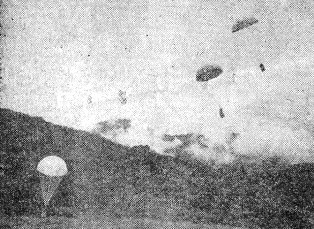 One down and one to go, as three parachutes waft to the ground. The pilots "bomb" with practiced accuracy.
One down and one to go, as three parachutes waft to the ground. The pilots "bomb" with practiced accuracy.
|
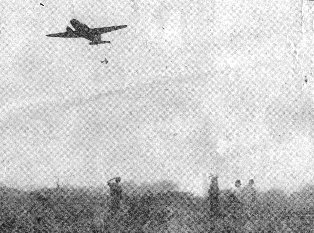 Silhouetted against the sky, a transport plane drops its load to an isolated outpost, while Naga Hill tribesmen and an American officer wait to collect the much-needed items.
Silhouetted against the sky, a transport plane drops its load to an isolated outpost, while Naga Hill tribesmen and an American officer wait to collect the much-needed items.
|
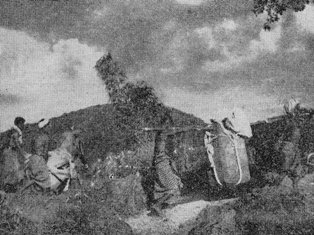 Naga hillsmen help carry the 'chutes and their loads to the base after they reach the ground. The Nagas are partially repaid with the 'chute cloth.
Naga hillsmen help carry the 'chutes and their loads to the base after they reach the ground. The Nagas are partially repaid with the 'chute cloth.
|
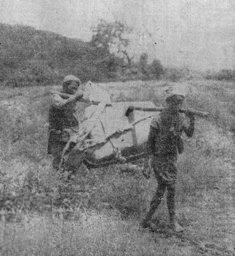 The size of the loads 'chuted down may be realized in their relation to the height of the Nagas shown carrying them.
The size of the loads 'chuted down may be realized in their relation to the height of the Nagas shown carrying them.
|
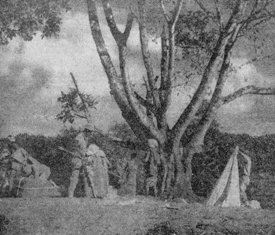 The bundles of vitally-needed supplies are brought from the dropping grounds to a place of safety under a tree,
clearing the "target area" for the parachuting of additional supplies.
The bundles of vitally-needed supplies are brought from the dropping grounds to a place of safety under a tree,
clearing the "target area" for the parachuting of additional supplies.
|
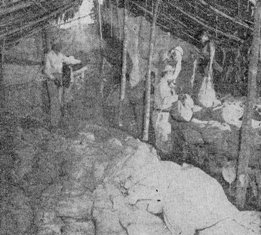 American Quartermaster troops direct the Nagas in stacking bundles in the bamboo basha warehouse for the sir-dropped
supplies.
American Quartermaster troops direct the Nagas in stacking bundles in the bamboo basha warehouse for the sir-dropped
supplies.
|
Pigs, Chickens, Ducks 'Chuted
To Chinese Units in Jungle
EASTERN INDIA AIRBASE - Live pigs, chickens and ducks have been dropped by parachute to Chinese units deep in the jungles of eastern India by the "Flying Grocery Store and Truck Line" commanded by Capt. George T. Oakley.
"The Chinese were having mid-autumn festival," Oakley said. "They prepare the meat in a special way and need it fresh."
"We dropped them 11 pigs weighing about 120 pounds each, 134 chickens and 121 ducks. The ducks and chickens floated down in baskets. We lashed parachutes on the backs of the pigs and passed the 'chute rigging under their bellies.
"They squealed a little when we pushed them into the sir from the door of the plane.
"Only one pig came to grief. He went down with the ripcord in his mouth, but I guess he forgot to pull it."
The C.B.I. Roundup is a weekly newspaper published by and for the men of the United States Army Forces in China, Burma, and India, from news and pictures supplied by staff members, soldier correspondents, the United Press, and the Army News Service. The Roundup is published Friday of each week and is printed by The Statesman in New Delhi, India. Editorial matter should be sent directly to Lt. Floyd Walter, Rear Echelon Hq., U.S.A.F., C.B.I., New Delhi, and should arrive not later than Monday in order to make that week's issue. Pictures must arrive by Sunday and must be negatives or enlargements. Stories should contain full name and organization of sender.

OCTOBER 15, 1943
Original issue of C.B.I. Roundup shared by Virginia Dyer, widow of CBI veteran Stanley Dyer.
Copyright © 2006 Carl Warren Weidenburner
SEE A PORTION OF THE ORIGINAL
TOP OF PAGE PRINT THIS PAGE ABOUT THIS PAGE SEND COMMENTS
PREVIOUS ISSUE CLOSE THIS WINDOW NEXT ISSUE
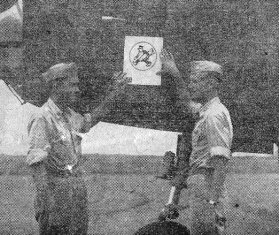 Lt. Col. Morris F. Taber, right, commanding officer of the "Sky Dragons," confers with his deputy commander, Maj. Allen
P. Forsyth, on the placing of the insignias on the Mitchells.
Lt. Col. Morris F. Taber, right, commanding officer of the "Sky Dragons," confers with his deputy commander, Maj. Allen
P. Forsyth, on the placing of the insignias on the Mitchells.